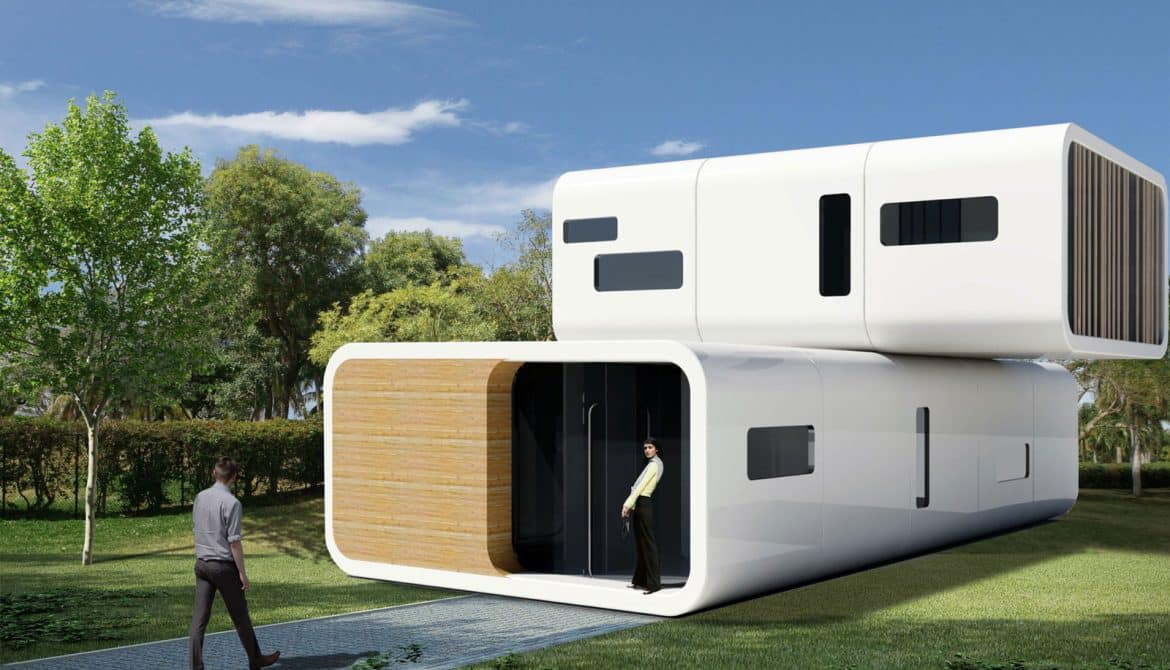Ever wondered how our dwellings and home ownership on land may evolve in the not-so-distant future? Imagine a world where simplicity, sustainability, and affordability converge into one lifestyle choice: tiny houses, offering the opportunity for home ownership through affordable dwellings and opening doors to numerous opportunities. As we navigate through economic uncertainties and environmental crises, the future of tiny houses, as dwellings that offer opportunities for home ownership and advantages, shines brightly as a beacon of hope for many. These compact abodes, or dwellings, aren’t just about downsizing physical space in terms of square feet; they’re about upsizing quality of life with advantages including better company.
The Advantages of Tiny Homes for Sustainable Living
Lower Footprint
Tiny homes have a smaller carbon footprint. This is because they use less space and energy. Heating and cooling a tiny house, with its fewer square feet, takes less power and time compared to larger homes, highlighting one of the advantages of smaller dwellings.
Also, many tiny houses use renewable energy sources. Solar panels are common on their roofs. This further reduces their environmental impact.
Affordability
One major advantage of tiny homes is their affordability. Building or buying a tiny house, a dwelling of a few hundred square feet, costs significantly less in time and money than traditional housing options offered by companies. Maintenance expenses are lower too.
This makes them an attractive option for people on tight budgets or those who prefer financial freedom over owning large properties.
Minimalist Lifestyle
Tiny houses encourage a minimalist lifestyle. Owners learn to live with less stuff, reducing waste and consumption.
Living in a smaller space means there’s no room for unnecessary items. People become more conscious about what they buy and keep.
-
Pros of tiny living include:
-
Less clutter
-
More savings
-
Greater environmental consciousness
-
-
Cons might be:
-
Limited space
-
Need for downsizing personal belongings
-
Transforming Real Estate with Tiny-Home Startups
Urban Appeal
Tiny homes have become a magnet for urban millennials. These compact living solutions offer an affordable and sustainable lifestyle, which is highly attractive in bustling cities. Many are drawn to the simplicity and minimalism that tiny homes, often measuring just a few hundred square feet, provide for individuals and companies alike.
Startups, or tiny homes company specializing in homes under a few hundred square feet, are innovating at a rapid pace. The company is designing houses that maximize square feet of space without sacrificing comfort or style. As land becomes scarcer in urban areas, these small dwellings, often measuring under a thousand square feet, present a viable solution for many seeking home ownership, attracting the attention of both individuals and companies.
City Partnerships
Some cities are partnering with tiny-home startups, companies specializing in homes under 400 square feet, to tackle housing shortages. This collaboration benefits both parties: cities address their need for affordable housing while startups, as one type of company, gain access to land and potential customers.
These company partnerships often lead to the development of tiny house communities. These communities not only provide housing but also foster a sense of belonging among residents. It’s an innovative approach to solving complex urban problems.
Investment Opportunities
The rise of tiny homes has opened new investment opportunities in real estate developments for companies. Investors see value in funding company projects that cater to the growing demand for compact, efficient living spaces.
Investing in tiny home developments can yield significant returns for a company due to low construction costs and high demand from buyers looking for affordable housing options.
Tiny House Communities as Sustainable Living Solutions
Shared Amenities
Tiny house communities are changing how we think about sustainability. They offer shared amenities like laundry facilities, gardens, and recreational areas. This setup reduces the need for individual resources.
Living in a tiny house means you use less energy and produce a smaller carbon footprint. With shared amenities, these benefits multiply across the community. It’s not just about saving space but also living more with less.
Social Connections
In these communities, neighbors become friends. The design of tiny house communities encourages interaction and support among residents. You’re never alone unless you choose to be.
This social aspect is vital for mental health and well-being. It creates a sense of belonging that many traditional housing options lack today.
Evolving Zoning Laws
Zoning laws are starting to catch up with the tiny house movement. More places now recognize tiny houses as permanent homes. This change is crucial for the growth of sustainable living spaces worldwide.
As zoning laws evolve, building a tiny home becomes easier. This shift supports those who wish to live sustainably without leaving urban areas.
Understanding Market Trends and Growth in Tiny Homes
Demand Surge
The pandemic has significantly changed how we view our living spaces. Many are now seeking affordable and flexible options. This shift is evident in the growing interest in tiny houses.
People want homes that don’t tie them down financially or geographically. With job losses and economic uncertainty, affordable housing is more crucial than ever. Tiny houses offer a solution to this problem. They cost less than traditional homes, making them accessible to more people.
Remote Work Influence
Remote work has become the new norm for many industries. This change has sparked an interest in mobile tiny homes.
Workers are no longer bound to live near their offices. They can travel or live anywhere while working remotely. Mobile tiny homes make this lifestyle possible and appealing.
This flexibility allows individuals to explore different places without the commitment of renting or buying property there. It’s a game-changer for those who love traveling but also need a stable workspace.
Environmental Awareness
Consumers today are more aware of their environmental footprint than ever before.
They seek sustainable living options that reduce waste and energy consumption. Tiny houses align with these values by requiring fewer materials to build and less energy to maintain.
This awareness influences buying decisions heavily towards tiny homes over traditional housing options.
Key Players in the Tiny Homes Market
Eco-Friendly Focus
Leading manufacturers are now prioritizing eco-friendly materials and designs. This shift is significant. It reflects a growing demand among people for sustainable living options. Many people are choosing tiny houses as a way to reduce their carbon footprint.
These manufacturers use recycled materials, solar panels, and rainwater harvesting systems. Such features make tiny homes more appealing to environmentally conscious buyers.
DIY Expansion
The rise of DIY tiny home kits has made building these homes more accessible to everyone. Anyone can now order a kit online and start constructing their own tiny house with basic tools and some help.
This trend has expanded the market significantly. It allows people with varying budgets and skills to join the tiny house movement.
Investor Interest
Real estate investors are diversifying portfolios by including tiny home properties. They see value in investing in smaller, more affordable housing options that appeal to many people looking for alternative living spaces.
Tiny homes offer investors a unique opportunity: they’re cheaper than traditional houses but still fetch good rental or resale values due to their popularity and sustainability features.
Technological Integration in Smart Tiny Homes
IoT Efficiency
IoT devices are revolutionizing tiny homes. They make small spaces smarter and more efficient. Imagine controlling lights, temperature, and even your coffee maker with a smartphone. This is not the future; it’s happening now.
These devices save space and energy. For example, smart thermostats adjust heating based on your habits. This means lower bills and a cozy home.
Renewable Energy
Solar panels are becoming essential for tiny houses. They harness the sun’s power to provide electricity. This is key for off-grid living or reducing energy costs.
Many tiny homeowners pair solar panels with batteries. This way, they store extra power for cloudy days. It’s a smart move towards sustainability.
Automation Comforts
Automation makes life in compact areas easier and more enjoyable. Think of automated blinds that adjust to sunlight or voice-activated gadgets that play music or set alarms without touching anything.
This technology also includes security features like smart locks and cameras you can monitor from anywhere.
Regulatory Changes Impacting Tiny Homes
Building Codes
Local governments are now revising building codes. This makes tiny home construction easier. For years, strict codes limited tiny house development. Now, changes aim to accommodate the growing trend.
Cities and towns across the country recognize the benefits of tiny living. They adjust regulations accordingly. This includes size requirements and zoning laws.
Legal Recognition
Tiny homes gain legal status as permanent residences. This shift is significant for owners and builders alike. Previously, many tiny houses were in a gray area legally.
The recognition helps in establishing communities of tiny homes. It also ensures these homes meet safety standards similar to traditional housing.
Insurance and Financing
Options for insurance and financing are expanding for tiny homeowners. Insurance companies now offer specific policies for these unique dwellings. Financing options have broadened as well.
Banks and lenders see the value in investing in the future of tiny houses. This makes owning a tiny home more accessible to people everywhere.
Innovative Space Utilization in Tiny Homes
Multi-Functional Furniture
Tiny homes are changing how we view living spaces. They make us rethink what’s essential. One key innovation is multi-functional furniture. Think of a table that transforms into a bed or a sofa with storage underneath. These pieces maximize the usability of small spaces.
This approach allows residents to do more with less square footage. It challenges traditional housing norms by showing that you don’t need separate rooms for every activity.
Architectural Innovations
Architects are getting creative with tiny houses too. They use design tricks to create an illusion of space within these dwellings. For example, high ceilings and large windows can make a tiny house feel much larger than it is.
Another tactic is the strategic use of mirrors to reflect light and visually expand areas. These innovations not only enhance living quality but also reduce construction costs by making smaller spaces more functional and appealing.
Vertical Storage Solutions
In tiny homes, floor space is precious. That’s where vertical storage comes in handy.
-
Shelves reaching up high
-
Hanging baskets
-
Wall-mounted desks
These options provide ample storage without taking up valuable floor area, enhancing living area functionality.
Vertical solutions offer opportunities to keep belongings organized in places where traditional storage might not work due to limited square feet availability.
Closing Thoughts
Tiny homes aren’t just a passing trend; they’re a revolution in how we think about space, sustainability, and community. You’ve seen the advantages, from environmental benefits to innovative market players, and how technology and regulations are shaping the future. It’s clear that tiny homes offer more than just a minimalist lifestyle—they promise a sustainable, tech-savvy, and community-oriented way of living that could redefine the very essence of home.
So, what’s your move? Whether you’re eyeing a tiny home for yourself or considering it as an investment, there’s no better time to dive in. The tiny house movement is gaining momentum, and with the right approach, you could be part of this transformative wave. Let’s think big by going small. Embrace the tiny house revolution and see where it takes you.


